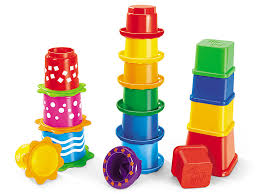Types of Sensory Toys
2024-07-30
Sensory toys are designed to stimulate and engage a child’s senses—sight, sound, touch, taste, and smell. These toys play a crucial role in the developmental stages of infants and toddlers, helping them to explore their environment and learn about the world around them. Here’s a look at different types of sensory toys and their benefits:
Types of Sensory Toys:
1. Touch and Texture Toys:
- Examples: Textured balls, sensory mats, soft fabric books.
- Benefits: Provide varied textures that help develop tactile discrimination and fine motor skills. They also offer soothing sensory experiences.
2. Sound Toys:
- Examples: Rattles, musical instruments, toys with bells or chimes.
- Benefits: Stimulate auditory senses and help with sound recognition and auditory processing. They can also improve hand-eye coordination as children learn to shake or bang toys to produce sound.
3. Sight Toys:
- Examples: Colorful rattles, light-up toys, toys with mirrors.
- Benefits: Enhance visual tracking, color recognition, and contrast sensitivity. Light-up toys also capture attention and stimulate visual curiosity.
4. Smell Toys:
- Examples: Toys with scents, like lavender-scented plush toys or playdough with different aromas.
- Benefits: Introduce different smells, which can be soothing or stimulating, and help develop the sense of smell and memory.
5. Taste Toys:
- Examples: Teething toys, safe sensory playdough or edible items.
- Benefits: For teething babies, taste toys soothe sore gums and provide sensory exploration. They should be made from safe, non-toxic materials.
6. Water and Bath Toys:
- Examples: Floating toys, bath squirters, water mats.
- Benefits: Enhance sensory exploration through water play, developing motor skills and hand-eye coordination. They also make bath time fun and engaging.
7. Interactive Toys:
- Examples: Toys with buttons, levers, or moving parts.
- Benefits: Offer hands-on engagement that promotes problem-solving skills, fine motor skills, and cause-and-effect understanding.
8. Fidget Toys:
- Examples: Fidget spinners, stress balls, sensory rings.
- Benefits: Help improve focus and concentration, provide calming effects, and aid in developing fine motor skills.
9. Musical Toys:
- Examples: Toy drums, xylophones, musical mats.
- Benefits: Encourage auditory exploration, rhythm, and coordination. They can also be soothing or energizing.
Benefits of Sensory Toys:
1. Cognitive Development:
- Learning Through Play: Sensory toys encourage exploration and problem-solving, laying the foundation for cognitive skills.
2. Motor Skill Development:
- Fine Motor Skills: Toys that involve manipulation and touch help refine fine motor skills and hand-eye coordination.
- Gross Motor Skills: Sensory toys that encourage movement support the development of gross motor skills.
3. Sensory Integration:
- Improved Processing: Sensory toys help children process and respond to sensory information, which is crucial for overall development and learning.
4. Emotional Regulation:
- Soothing Effects: Sensory toys can provide comfort and help children manage stress or anxiety, especially those with sensory processing disorders.
5. Social Skills:
- Interactive Play: Sensory toys can be used in social play settings, helping children learn to share, take turns, and interact with others.
6. Language Development:
- Vocabulary Building: Talking about different textures, sounds, and sensations helps build language skills and understanding.
Choosing Sensory Toys:
1. Safety:
- Ensure that the toys are made from non-toxic, child-safe materials and do not have small parts that could be a choking hazard.
2. Age Appropriateness:
- Select toys that are suitable for the child’s developmental stage and abilities.
3. Variety:
- Offer a range of sensory toys to stimulate different senses and provide diverse experiences.
4. Quality:
- Choose well-made toys that can withstand frequent use and handling.
Sensory toys are valuable tools in early childhood development, providing engaging and educational experiences that support sensory processing, motor skills, and cognitive growth.



